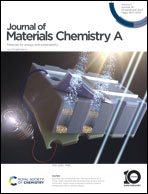Stacking polytypes of 1T′ phase Se-rich transition metal diselenide and their electrocatalytic activity in the hydrogen evolution reaction†
Abstract
Transition metal dichalcogenides exhibit various stacking polytypes and distinct electronic structures. In this study, first-principles calculations show that chalcogen enrichment induces the phase conversion from 2H to 1T′. Models for Se intercalation and substitution (MoSex and WSex with x > 2) were constructed for the 2H and three stacking polytypes of the 1T′ phase (1T′, 2M, and Td). Se intercalates and substitutes more favorably into the 1T′ polytypes than into the 2H phase. Intercalation in the 1T′ polytypes occurs by forming Se dimers, which is distinct from the Se monomer in the 2H phase. The relative stability predicts that as x increases, the 2H phase undergoes phase conversion preferentially into the 2M phase. On the experimental side, we synthesized Se-rich MoSe2 and WSe2 nanosheets using a colloidal reaction, and confirmed the stacking sequence of the 2M phase using atomic-resolution scanning transmission electron microscopy. The Se-rich 2M phase nanosheets exhibited enhanced electrocatalytic performance in the hydrogen evolution reaction (HER). Gibbs free energy calculations support that excess Se enhances the HER.



 Please wait while we load your content...
Please wait while we load your content...